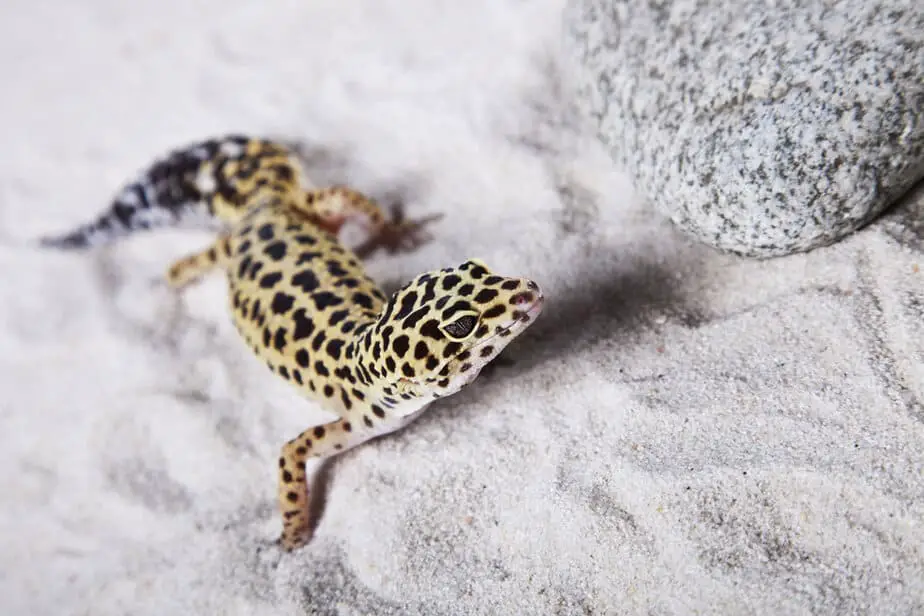One of the most important decisions you’ll make while setting up your leopard gecko’s tank is picking the right substrate. While calcium sand is a popular option, many of us aren’t sure whether it’s suitable for our leopard geckos. So, is it?
Calcium sand is not good for leopard geckos. In fact, it’s unsafe for them. Leopard geckos cannot digest calcium sand. So it ends up accumulating in their stomachs. Eventually, this can lead to impaction and other problems.

Why do some leopard gecko owners use calcium sand as a substrate?
Most leopard gecko owners who use calcium sand as a substrate do so because it contains calcium – a nutrient that these reptiles need. Also, calcium sand looks nice and is easy to clean. However, this is a massive mistake.
If you want to get more calcium in your leopard geckos diet, try calci-worms.
Why is calcium sand bad for leopard geckos?
There are three main reasons that calcium sand is bad for leopard geckos. These are:
It’s difficult to digest
Calcium sand is made up of around 95% calcium carbonate, which is the limestone’s main ingredient.
This compound makes calcium sand insoluble in water and prone to forming clumps when wet. It also makes it react with acids to create carbon dioxide.
Ultimately, it is this reactivity that makes calcium carbonate a key ingredient of a lot of antacids.
However, this same quality will neutralize most of the acid in your leopard gecko’s gut, reducing it to dangerous levels. Meaning your gecko won’t have enough acid to digest its food properly.
This is more likely to happen if your leopard gecko eats the sand outside of feeding times – they produce less stomach acid at this time.
When this happens, the remaining undigested calcium sand accumulates in your leopard gecko’s stomach. This causes discomfort and digestion problems like impaction.
It produces dust
If there’s one thing that all calcium carbonate substrates have in common, they produce dust. This dust is irritating and can lead to respiratory issues, especially when exposure is repetitive.
While some people try to reduce this dust by washing the calcium sand before using it, this leads to another problem. Since these sand particles don’t hold water well, they can make regulating the tank’s humidity difficult.
It can stain your leopard gecko’s skin
Calcium sand has been known to stain leopard gecko skin. Some people have even complained that the sand has turned the skin of their pets black.
Related: Learn if Leopard Geckos are Omnivores
What else can you use as a substrate in your leopard gecko’s tank?
If you want to stop using calcium sand but are wondering what better options are available out there, here are some suggestions for you:
Paper towels
These are one of the safest substrate options. They are not only highly absorbent but also easy to change. They are cheap and readily available. This makes them popular among leopard gecko owners, especially those with babies.
However, using paper towels does have its disadvantages. For one, it creates an unnatural look in your gecko’s tank, making it too uncomfortable to perform some natural behaviors like digging.
Also, they can make it hard for adult leopard geckos to grip anything. And let’s not even talk about the environmental impact of paper towel manufacturing.
Newspapers
Like paper towels, newspapers are absorbent. Using them is environmentally friendly since it’s a recycling/repurposing method.
It also helps that using them is easy – you just have to dry them for one week before applying them on the tank’s floor. However, they are still unnatural.
Reptile carpet
This is a type of artificial substrate that is both supportive and absorbent. It offers adequate grip and comes with cleaning instructions from manufacturers.
The instructions usually cover how to wash the carpet and how long you have between washes.
Remember that washing your carpet will make its fibers stick out, though. Ultimately, this can easily get your leopard gecko’s fingers stuck.
Tiles
You can easily use slate, ceramic, and even stone tiles in your leopard gecko’s tank. They are readily available and easy to clean. You can even customize them to look more natural.
Bioactive substrates
These substrates are designed to look natural and usually contain gravel, soil, and clay. They even come with some microorganisms and live plants.
The former works to break down any waste. Bioactive substrates are usually expensive to buy and maintain.
Final thoughts
No matter how you look at it, calcium sand isn’t suitable for leopard geckos. It increases their chances of impaction, respiratory issues, and even skin irritation.
To make matters worse, it’s even expensive. So avoid using it as a substrate – many better options are available!
